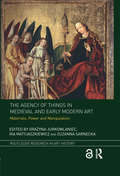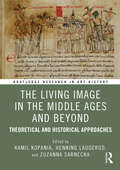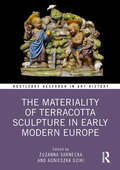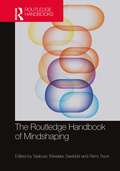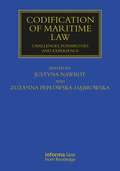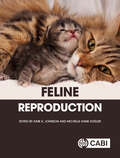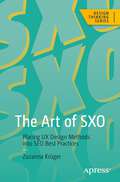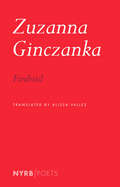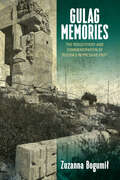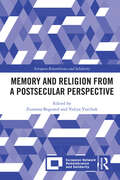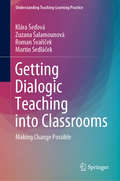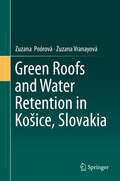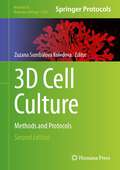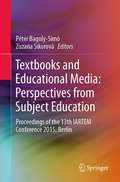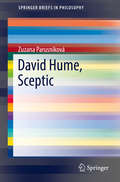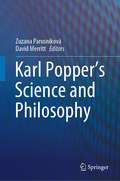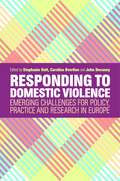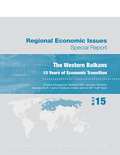- Table View
- List View
The Agency of Things in Medieval and Early Modern Art: Materials, Power and Manipulation (Routledge Research in Art History)
by Grażyna Jurkowlaniec Ika Matyjaszkiewicz Zuzanna SarneckaThis volume explores the late medieval and early modern periods from the perspective of objects. While the agency of things has been studied in anthropology and archaeology, it is an innovative approach for art historical investigations. Each contributor takes as a point of departure active things: objects that were collected, exchanged, held in hand, carried on a body, assembled, cared for or pawned. Through a series of case studies set in various geographic locations, this volume examines a rich variety of systems throughout Europe and beyond.
The Living Image in the Middle Ages and Beyond: Theoretical and Historical Approaches (Routledge Research in Art History)
by Zuzanna Sarnecka Henning Laugerud Kamil KopaniaThis edited volume discusses images that bleed, speak, cry, move, and behave in ways we usually attribute to living creatures.Living images have been the object of devotion as well as targets of destruction, and they have been marginalised in both culture and cultural studies for their ambivalence as well as their transgressive nature. But what is it that makes images the loci of such powerful properties? The present volume is an attempt to recuperate the living image, draw it from the margins, and re-illuminate its importance for cultural history. The title of this book reflects the ambition of the contributions to navigate between the Middle Ages of the past and the Middle Ages of the present. Our aim is to provide new theoretical reflections and methodologies concerning the study of material agency and “living images” both historically and today. The chapters include close examination of surviving objects and archival research, as well as theoretical reflections, and span chronologically and geographically across Europe from North to South, medieval to modern.The book will be of interest to scholars working in art history, medieval studies, material culture, theatre studies, and religious history.
The Materiality of Terracotta Sculpture in Early Modern Europe (Routledge Research in Art History)
by Zuzanna Sarnecka Agnieszka DzikiThrough meticulously researched case studies, this book explores the materiality of terracotta sculpture in early modern Europe. Chapters present a broad geographical perspective showcasing examples of modelling, firing, painting, and gilding of clay in Portugal, Spain, Italy, Germany, and the Netherlands. The volume considers known artworks by celebrated artists, such as Luca della Robbia, Andrea del Verrocchio, Filipe Hodart, or Hans Reichle, in parallel with several lesser-studied terracotta sculptures and tin-glazed earthenware made by anonymous artisans. This book challenges arbitrary distinctions into the fine art and the applied arts, that obscured the image of artistic production in the early modern world. The centrality of clay in the creative processes of artists working with two- and three-dimensional artefacts comes to the fore. The role of terracotta figures in religious practices, as well as processes of material substitutions or mimesis, confirm the medium’s significance for European visual and material culture in general. This book will be of interest to scholars working in art history, Renaissance studies, and material culture.
The Routledge Handbook of Mindshaping (Routledge Handbooks in Philosophy)
by Daniel Kelly Wynn C. Stirling Michelle Maiese Jaroslav Peregrin Don Ross Sam Wilkinson Fredrik Stjernberg Shannon Spaulding Julian Kiverstein Ladislav Koreň Eric Funkhouser Ian Apperly Marc Slors Kristina Musholt Alessandra Tanesini Christopher Jude McCarroll Julia Wolf Fernando Martínez-Manrique Tadeusz Wiesław Zawidzki Rémi Tison Nikola Andonovski Virginia Ballesteros Leda Berio Devin Sanchez Curry Laura Danón Léon De Bruin John Dorsch Matej Drobňák Víctor Fernández-Castro Colum Finnegan Simon Fitzpatrick Marianna B. Ganapini Adam Gies Trip Glazer James Grayot J. P. Grodniewicz Núñez de Prado-Gordillo, Miguel Lucy Osler Dennis Papadopoulos Daniel Pérez-Zapata Uwe Peters Enrico Petracca Zuzanna Rucińska Ayana Samuel Derek Strijbos Brandon Tinklenberg Mason Westfall Evan WestraOf all species, human beings are uniquely capable of coordinating on long-term, large-scale cooperative projects with unfamiliar and genetically unrelated others. According to the mindshaping hypothesis, this relies on mechanisms and practices like imitation, pedagogy, normative cognition, and narrative self-constitution, which shape us into expert coordinators, without requiring time consuming and epistemically fraught attempts to read each other’s minds. Mindshaping has been applied to many areas of inquiry, including game theory, shared agency, communication, the ontogeny of human cognition, the dissemination of scientific knowledge in popular media, mental illness, and the influence of social media technologies.The Routledge Handbook of Mindshaping is the first volume of its kind. Comprising 37 chapters by an international team of leading scholars, this Handbook is organised into seven sections: Mindshaping and coordination Mindshaping and cognitive psychology Mindshaping and normativity Mindshaping and epistemology Social and political dimensions of mindshaping Nonhuman mindshaping Mindshaping applied Within these sections, key topics are addressed, including game theory, social signalling and shared agency, folk psychology, the emotions, language acquisition and memory, stereotyping and consciousness-raising, moral agency, self-knowledge, rationality, epistemic norms, primate sociality, human-elephant relations, artificial intelligence, mental illness and neurodiversity, aesthetic expression, and politics.An outstanding survey of a vibrant and emerging field, The Routledge Handbook of Mindshaping will be of great interest to those studying and researching philosophy of psychology, philosophy of cognitive science, philosophy of mind, and applied epistemology. It will also be of interest to those in related disciplines such as cognitive psychology, sociology, and anthropology.
Codification of Maritime Law: Challenges, Possibilities and Experience (Maritime and Transport Law Library)
by Justyna Nawrot Zuzanna Pepłowska-DąbrowskaThis book is the first of its kind to explore the problems inherent in the unification of maritime law. Featuring contributions from leading experts at European maritime law research centres, it considers international conventions, current maritime practice, standard forms and recently adopted or drafted national codifications of maritime law from the codification point of view. The book is divided into four parts which represent different views on the main topic. Part I gathers chapters dedicated to different aspects and methods of unification of maritime law on a global scale, as well as several specific issues of maritime law from the regulatory point of view. Part II of the book consists of those papers that centre around the issue of transport of goods. Part III is dedicated to codifications of carriage of passengers, cruise law and leisure navigation. Finally, Part IV addresses national codifications of maritime law. Codification of Maritime Law: Challenges, Possibilities and Experience seeks to provide common ground for future unification of maritime law, which makes the book useful both for private and public maritime lawyers and states’ maritime administrations worldwide.
The Pearl of Dari: Poetry And Personhood Among Young Afghans In Iran (Public Cultures Of The Middle East And North Africa Ser.)
by Zuzanna OlszewskaThe Pearl of Dari takes us into the heart of Afghan refugee life in the Islamic Republic of Iran through a rich ethnographic portrait of the circle of poets and intellectuals who make up the "Pearl of Dari" cultural organization. Dari is the name by which the Persian language is known in Afghanistan. Afghan immigrants in Iran, refugees from the Soviet war in Afghanistan, are marginalized and restricted to menial jobs and lower-income neighborhoods. Ambitious and creative refugee youth have taken to writing poetry to tell their story as a group and to improve their prospects for a better life. At the same time, they are altering the ancient tradition of Persian love poetry by promoting greater individualism in realms such as gender and marriage. Zuzanna Olszewska offers compelling insights into the social life of poetry in an urban, Middle Eastern setting largely unknown in the West.
Feline Reproduction
by Natalie S Fraser Carla Barstow Marco Cunto Diane Delmain Jaime M. Douglas Alain Fontbonne Cristina Gobello Sandra Goericke-Pesch Fiona Hollinshead Jacob A. Johnson Cindy Maenhoudt Jennifer Nagashima Zuzanna Niewiadomska Budhan Pukazhenthi Juliette Roos William F. Swanson Riley E. Thompson Lindsey M. Vansandt Daniele ZambelliCats are one of the most popular pets in the world and cat owners want advanced veterinary care. There is a growing interest in purebred cats which requires the highest quality reproductive care from the general veterinary practitioners. In Feline Reproduction, all aspects of reproduction in the queen and the tom are presented by a global author team. Beginning with basic anatomy and normal reproduction, this book reviews practical knowledge about feline pregnancy, neonatal care, breeding soundness exams, and semen cryopreservation. This book also provides the most current and comprehensive information about abnormal conditions affecting feline reproduction, such as infertility, spontaneous abortion and contraception. Covering both pets and nondomestic species, this feline reproduction book will prove to be essential for the general veterinary practitioner, veterinary student, animal scientist, and experienced cat breeder.
The Art of SXO: Placing UX Design Methods into SEO Best Practices (Design Thinking)
by Zuzanna KrügerSearch Experience Optimization (SXO) is a fast growing field that combines the disciplines of Search Engine Optimization (SEO), Conversion Rate Optimization (CRO) and User Experience (UX) Design. It’s a holistic approach to creating websites that are not only optimized for search engines and bots, but for users too, a highly effective method of converting a websites visitors into customers and subscribers, leading some to think of it as SEO 2.0. Recent industry reports suggests that front-end developers and web designers need to embrace SXO best practices to not only ensure websites are optimized by the metadata and analytics that SEO provides, but also ensure a website or application is easy-to-use and behaves in a way the user expects because happy users drive higher retention rates and higher revenue, which is essential for commercial app creators. The Art of SXO aims to be a comprehensive guide to this emerging field, explaining what it is, how it works, and how to use it to improve search rankings, increase conversions rates, and ultimately grow a company's revenue. This guide will be packed with tips, tricks, and tactics making it an essential resource for anyone looking to get the most out of their search traffic.What You'll LearnApply SXO best practices and how it differs from tradition SEOOptimize websites for both search engine bots and users Increase a website's ranking in SERPsImprove a website's conversion ratesGrow revenue from organic trafficWho This Book Is ForWeb developers and UX designers, technical SEO specialists, digital marketers and business owners who may have a basic understanding of SEO, CRO, UX design and core digital marketing concepts, but are looking to take their practices to the next level with SXO.
Firebird
by Zuzanna GinczankaEnergetic, formally audacious poems by a recently rediscovered Polish writer, shining examples of art as resistance.Zuzanna Ginczanka&’s last poem, &“Non omnis moriar..." (&“Not all of me shall die&”), written shortly before her execution by the Nazis in the last months of World War II, is one of the most famous and unsettling texts in modern East European literature: a fiercely ironic last will and testament that names the person who betrayed her to the occupying authorities as a Jew, it exposes the hypocrisy at the heart of Polish nationalist myths.Ginczanka&’s linguistic exuberance and invention—reminiscent now of Marina Tsvetaeva, now of Marianne Moore or Mina Loy—are as exhilarating as the passionate fusion of the physical world and the world of ideas she advocated in her work. Firebird brings together many of Ginczanka&’s uncollected poems and presents On Centaurs, her sole published book, in its entirety.
Gulag Memories: The Rediscovery and Commemoration of Russia's Repressive Past
by Zuzanna BogumiłThough the institution of the Gulag was nominally closed over half a decade ago, it lives on as an often hotly contested site of memory in the post-socialist era. This ethnographic study takes a holistic, comprehensive approach to understanding memories of the Gulag, and particularly the language of commemoration that surrounds it in present-day Russian society. It focuses on four regions of particular historical significance—the Solovetsky Islands, the Komi Republic, the Perm region, and Kolyma—to carefully explore how memories become a social phenomenon, how objects become heritage, and how the human need to create sites of memory has preserved the Gulag in specific ways today.
Memory and Religion from a Postsecular Perspective (European Remembrance and Solidarity)
by Zuzanna Bogumił Yuliya YurchukThe book argues that religion is a system of significant meanings that have an impact on other systems and spheres of social life including cultural memory. The editors call for a postsecular turn in memory studies which would provide a more reflective and meaningful approach to the constant interplay between the religious and the secular. This opens up new perspectives on the intersection of memory and religion and helps memory scholars become more aware of the religious roots of the language they are using in their studies of memory. By drawing on examples from different parts of the world, the contributors to this volume explain how the interactions between the religious and the secular produce new memory forms and content in the heterogenous societies of the present-day world. These analysed cases demonstrate that religion has a significant impact on cultural memory, family memory and the contemporary politics of history in secularized societies. At the same time, politics, grassroots movements and different secular agents and processes have so much influence on the formation of memory by religious actors that even religious, ecclesiastic and confessional memories are affected by the secular. This volume is ideal for students and scholars of memory studies, religious studies and history.
Getting Dialogic Teaching into Classrooms: Making Change Possible (Understanding Teaching-Learning Practice)
by Klára Šeďová Zuzana Šalamounová Roman Švaříček Martin SedláčekThis book contributes to our understanding how teachers can improve classroom dialogue and thereby boost student learning.The book reports the results of intervention research based on professional development program for teacher. Participating teachers strived, with the help of the researchers, to instigate a rich and authentic dialogue in their classrooms. The data shows that teachers were able to change their talk and interaction patterns, and this was followed by a desirable change in their students who started to talk more and expressed more complex thoughts.The book not only reports on a successful intervention, but most importantly investigates in depth the teacher experiences and ways of learning during the intervention project.
Soft Target Protection: Theoretical Basis and Practical Measures (NATO Science for Peace and Security Series C: Environmental Security)
by Ladislav Hofreiter Viacheslav Berezutskyi Lucia Figuli Zuzana ZvakováThis proceedings volume includes articles presented during the Advanced Research Workshop on Soft Target Protection. The book presents important topics related to the protection of vulnerable objects and spaces, called Soft Targets. The chapters published in this book are thematically assigned to the blocks as follows: Theoretical aspect of soft target protection; Blast resistance of soft targets; Counter terrorism; Technical and technological solutions for soft target protection; Scheme and organizational measures; Blast protection and Forces for soft target protection. In this book, the reader will find a wealth of information about the theoretical background for designing protection of soft targets, as well as the specifics of protecting objects in armed conflict areas. New methods and procedures applicable to the soft target protection are described.
Green Roofs and Water Retention in Košice, Slovakia
by Zuzana Poórová Zuzana VranayováThis book discusses how climate change and heat islands are a main contributor to water related problems in urban areas in Košice, Slovakia. Green roofs are used as a tool to assist in solving these water related issues. The need to provide housing in urban areas is expected to rise to 66% in 2050, according to the United Nations. Many urban areas have seen natural permeable green areas replaced with concrete constructions and hard, non-permeable surfaces. The densification of existing built-up areas is responsible for the decreasing vegetation, which results in the lack of evapotranspiration cooling the air, thereby creating urban heat islands. Several studies, discussed in this book, have shown that natural and permeable surfaces, as in the case of green roofs, can play a crucial role in mitigating this negative climate phenomenon and providing higher efficiency for buildings, leading to savings such as water, one of the focal points of this research.
Sponge City Hybrid Infrastructure (Earth and Environmental Sciences Library)
by Martina Zelenakova Abdelazim Negm Zuzana VranayovaThis book focuses on the access to water in the building and its surroundings, to infer the mutual interaction and the complex interconnection of green/blue infrastructures. This book is a tool for understanding the multifunctional functionality of urban waste water to recognize their efficient and strategically useful potential in the form of aesthetic and functional architectural elements—vertical gardens, waterproof roof systems, rain gardens, retention rainwater recirculation tanks, biomarkers for wastewater treatment, and other progressive technologies and technical solutions. The originality of the proposed book and the innovation of the proposed objectives lies in the complexity and interdisciplinary of the problem solved, with clear continuity and utilization in professional building, environmental, and psychosocial practice. Understanding the quality of life as a category influenced by several objective and subjective conditions, this manuscript draws up recommendations on how to build “green buildings”—progressively supplied with water, connecting infrastructures—from existing buildings (administrative or training).
3D Cell Culture: Methods and Protocols (Methods in Molecular Biology #2764)
by Zuzana Sumbalova KoledovaSince the publication of the previous edition, the use of 3D cell and organoid cultures has become more widespread across laboratories. This second edition volume expands on the previous edition with discussions about the latest organoid models developed for many more organs; new hydrogels and devices for 3D culture; and the organoid systems that have been improved by incorporating more components of tissue microenvironments in the in vitro culture. The chapters in this book are organized into five parts and cover topics such as biofabrication, organoids, microfluidic systems, bioprinting, and image analysis. Written in the highly successful Methods in Molecular Biology series format, chapters include introductions to their respective topics, lists of the necessary materials and reagents, step-by-step, readily reproducible laboratory protocols, and tips on troubleshooting and avoiding known pitfalls.Thorough and cutting-edge, 3D Cell Culture: Methods and Protocols, Second Edition is a valuable resource that will stimulate new ideas, foster interdisciplinary collaborations, and contribute to the improvement of human health and well-being.
Textbooks and Educational Media: Proceedings of the 13th IARTEM Conference 2015, Berlin
by Péter Bagoly-Simó Zuzana SikorováThis book brings together empirical research and conceptual work on textbooks and education media from 13 countries and 17 disciplines. Along with textbook production, usage, and development, it also explores the interconnectedness of (educational) policy and teaching and learning materials. Further, the book offers insights into regional and local discourses (e.g. specific theories of Portuguese- and Spanish-speaking countries as well as Nordic countries, contrasting their theories with international literature), practices, and solutions with regard to teaching selected subjects at the pre-primary, primary, secondary, and tertiary level. This book also discusses the specific combinations of subjects (e.g. Physics, Biology, Geography, Swedish, English) and their subject-specific education (e.g. Physics Education or Didactics). Lastly, it examines the work of a number of early-career researchers, giving them a voice and bringing in fresh ideas currently being developed in various countries around the globe.This proceedings volume will appeal to publishers, subject educators in primary, secondary, and tertiary education, and academic researchers from the fields of textbooks, educational media and subject-specific education. Its international authorship and explicit focus on subject-specific particularities of educational media provide a unique and comprehensive overview.
David Hume, Sceptic (SpringerBriefs in Philosophy)
by Zuzana ParusnikováThis book studies Hume’s scepticism and its roots, context, and role in the philosopher’s life. It relates how Hume wrote his philosophy in a time of tumult, as the millennia-old metaphysical tradition that placed humans and their cognitive abilities in an ontological framework collapsed and gave way to one that placed the autonomy of the individual in its center. It then discusses the birth of modernity that Descartes inaugurated and Kant completed with his Copernican revolution that moved philosophy from Being to the Self. It shows how modernity gave rise to a new kind of scepticism, involving doubt not just about the adequacy of our knowledge but about the very existence of a world independent of the self. The book then examines how Hume faced the sceptical implications and how his empiricism added yet another sceptical theme with the main question being how argument can legitimize key concepts of human understanding instinctively used in making sense of our perceptions. Placing it firmly in a historical context, the book shows how Hume was influenced by Pyrrhonian scepticism and how this becomes clear in Hume’s acceptance of the weakness of reason and in his emphasis on the practical role of philosophy. As the book argues, rather than serving as the foundation of science, in Hume’s hand, philosophy became a guide to a joyful, happy life, to a documentary of common life and to moderately educated, entertaining conversation. This way Hume stands in strong opposition to the (early) modern mainstream.
Karl Popper's Science and Philosophy
by Zuzana Parusniková David MerrittOf all philosophers of the 20th century, few built more bridges between academic disciplines than Karl Popper. He contributed to a wide variety of fields in addition to the epistemology and the theory of scientific method for which he is best known. This book illustrates and evaluates the impact, both substantive and methodological, that Popper has had in the natural and mathematical sciences. The topics selected include quantum mechanics, evolutionary biology, cosmology, mathematical logic, statistics, and cognitive science. The approach is multidisciplinary, opening a dialogue across scientific disciplines and between scientists and philosophers.
Responding to Domestic Violence: Emerging Challenges for Policy, Practice and Research in Europe
by Elizabeth Martin Julie Taylor Stephanie Holt Per Moum Hellevik Gene Feder John Devaney Dr Declan Coogan Carolina Øverlien Joanna Goodey Philip McCormack Zuzana Ocenasova Hana Smitkova Claire Houghton Sibel Korkmaz Maria Pentaraki Nicola McConnell Matt Barnard Nusha Yonkova Gloria Kirwan Dalila Cerejo Els Leye Ingunn Rangul Askeland Marius Råkil Lucy Potter Gemma Carney Davina James-HanmanThis book offers a critical overview of established and emerging manifestations of domestic violence across Europe. It describes how countries within and outside the EU are responding to the problem in policy, practice and research. Eminent academics and professionals from a range of European countries share their findings from new groundbreaking victim surveys, and weigh up the legal, social and healthcare challenges. The issues addressed include: - the cultural challenges of combating abuse forms most prevalent in migrant communities such as female genital mutilation and forced marriage; - emerging problems such as child-to-parent violence, teenage relationship violence and digital intimate partner abuse; and - barriers to help-seeking faced by marginalised victims such as LGBTQ and older people. By showcasing the most effective responses formulated in Europe and exploring innovative ways to research and understand domestic violence, this book is a crucial resource for all those with responsibility for implementing social policy and good practice.
Adopting the Euro in Central Europe
by Susan Schadler Paulo Drummond Louis Kuijs Zuzana Murgasova Rachel Van ElkanUpon entry into the European Union (EU), countries become members of the Economic and Monetary Union (EMU), with a derogation from adopting the euro as their currency. This paper examines likely economic developments and policy challenges for the five former transition countries in central Europe (the Czech Republic, Hungary, Poland, the Slovak Republic and Slovenia) which joined the EU in May 2004. These economies operate independent monetary policies but have not yet achieved policy convergence with the rest of the euro area.
Post-Transition Investment Behavior in Poland: A Sectoral Panel Analysis
by Zuzana MurgasovaA report from the International Monetary Fund.
Regional Economic Issues, April 2015: 15 Years of Economic Transition
by Zuzana Murgasova Alasdair Scott Jacques Miniane Ivanna Vladkova-Hollar Nadeem Ilahi Imf Staff TeamA report from the International Monetary Fund.
Uganda and Rwanda: Selected Issues
by Zuzana MurgasovaA report from the International Monetary Fund.
Constructing the Image of the Mexican Revolution
by Zuzana M. PickWith a cast ranging from Pancho Villa to Dolores del Río and Tina Modotti, Constructing the Image of the Mexican Revolution demonstrates the crucial role played by Mexican and foreign visual artists in revolutionizing Mexico's twentieth-century national iconography. Investigating the convergence of cinema, photography, painting, and other graphic arts in this process, Zuzana Pick illuminates how the Mexican Revolution's timeline (1910-1917) corresponds with the emergence of media culture and modernity. Drawing on twelve foundational films from Que Viva Mexico! (1931-1932) to And Starring Pancho Villa as Himself (2003), Pick proposes that cinematic images reflect the image repertoire produced during the revolution, often playing on existing nationalist themes or on folkloric motifs designed for export. Ultimately illustrating the ways in which modernism reinvented existing signifiers of national identity, Constructing the Image of the Mexican Revolution unites historicity, aesthetics, and narrative to enrich our understanding of Mexicanidad.
